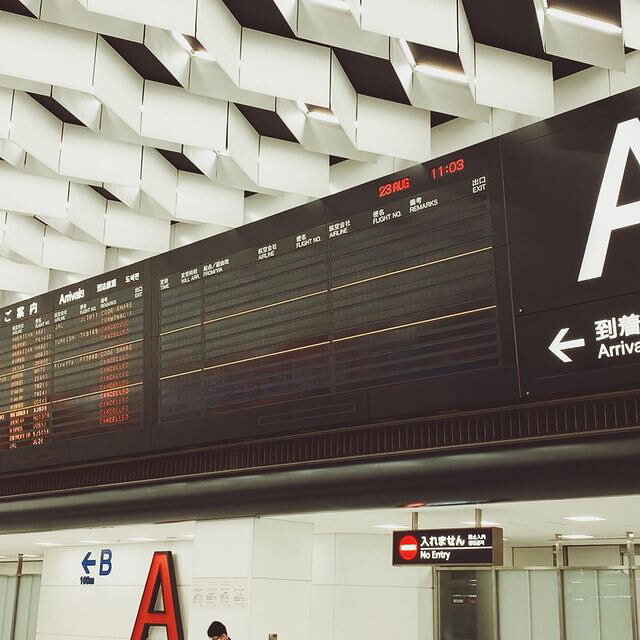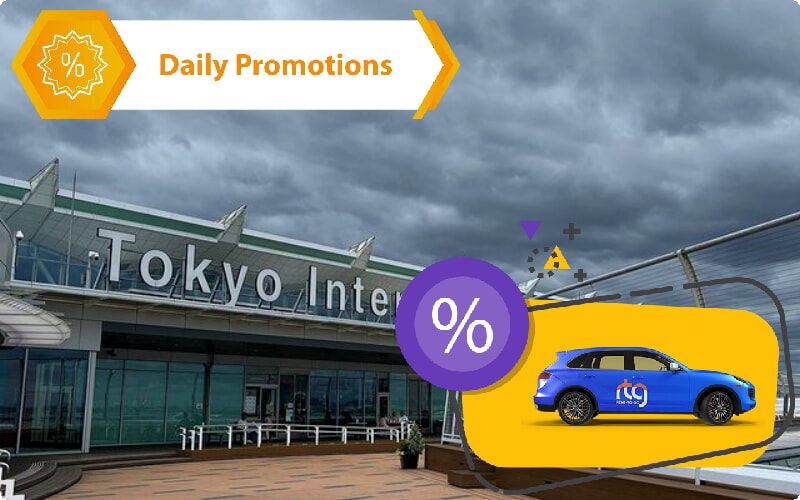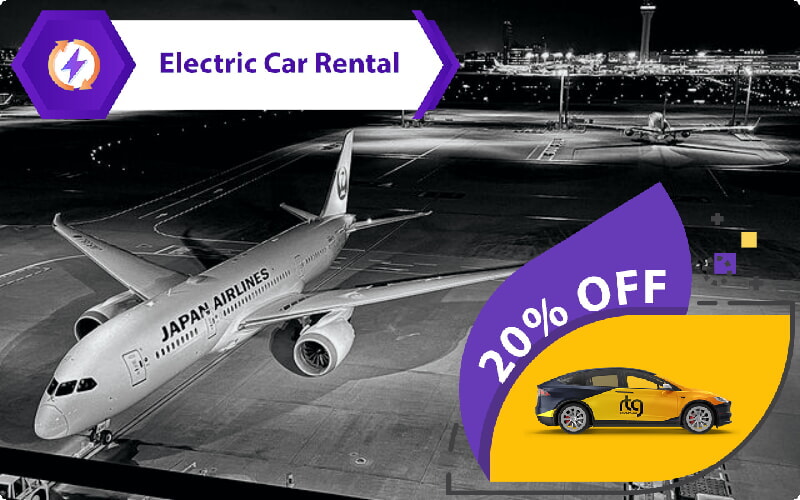 Up to
-35%
Up to
-35%
Hiring a car at Tokyo Airport can be a convenient way to explore the vibrant city and its surrounding areas. Here’s a comprehensive guide to help you navigate the car rental process at Tokyo's major airports, Narita International Airport (NRT) and Haneda Airport (HND).
Both Narita and Haneda airports host a variety of car rental companies, including international brands and local providers. Some of the well-known companies include:
It is highly recommended to book your car in advance, especially during peak travel seasons. This ensures availability and often results in better rates. Most rental companies offer online booking options, making the process straightforward and convenient.
Car rental desks are typically located in the arrivals area of both Narita and Haneda airports. Clear signage will guide you to the rental counters. For drop-off, most companies provide easy access to return areas within the airport premises, ensuring a hassle-free experience.
Driving in Tokyo can be challenging due to heavy traffic and complex road systems. Here are a few tips:
By following these guidelines, you can enjoy a smooth and enjoyable car rental experience at Tokyo Airport, giving you the freedom to explore the city and beyond at your own pace.

Renting an electric car at Tokyo Airport is a convenient and eco-friendly option for travelers. Several popular electric car models are available for rent, each offering a unique blend of performance, comfort, and sustainability. Here are some of the top choices and their average daily rental rates:
These rates provide a general idea of the cost of renting an electric car at Tokyo Airport, allowing travelers to choose a vehicle that best suits their needs and budget.




One way car rentals from Tokyo Airport offer flexibility for travelers looking to explore Japan without the need to return the vehicle to the original location. Several car rental companies provide this service, allowing you to drop off the car in another city. For instance, renting a car at Tokyo Airport and returning it in Osaka can cost around €100-€150 extra, depending on the car type and rental duration. Similarly, a one-way rental to Kyoto might incur an additional fee of approximately €80-€120.
These fees are in addition to the standard rental rates, which vary based on the vehicle category and rental period. It's advisable to compare prices and terms from different rental companies to find the best deal. One way rentals are ideal for those planning a road trip across Japan, offering the convenience of starting and ending your journey in different cities.

One of the simplest yet most effective ways to save on car rentals is to book well in advance. This is particularly important in tourist-heavy locations, where demand for rental cars can spike during popular travel seasons. By booking ahead of time, you can take advantage of lower rates and ensure that your preferred vehicle type is available.
Many car rental companies in Tokyo Airport offer "early-bird" specials to customers who book weeks or even months ahead of their planned rental dates. These deals can offer significant discounts, sometimes up to 20% or 30% off the regular price. Booking in advance is especially beneficial if you plan to travel during peak seasons when prices are likely to soar due to high demand.
Booking ahead not only helps you save money but also gives you the flexibility to shop around and compare prices from different suppliers. If your travel dates are flexible, you can also adjust them to periods when rates are lower, ensuring even more savings.
For the best deals, consider using our website, r-tg.com. We aggregate rates from various suppliers, providing you with a one-stop shop for comparison. The site often features exclusive early-bird specials and promotional discounts that you won't find anywhere else. It's an excellent resource for locking in the lowest possible rate for your rental car in Tokyo Airport.
One of the most effective ways to save money on car rentals is to shop around and compare rates from multiple suppliers in Tokyo Airport. Not all rental agencies are created equal, and prices can vary significantly even for the same class of vehicle.
Suppose you're interested in renting a compact car, such as a Opel Corsa. Your first instinct might be to go with well-known suppliers like sixt or budget, but it's crucial to also consider lesser-known local agencies. These local suppliers might offer competitive rates to entice customers away from the bigger names.
For instance, a Opel Corsa at sixt in Tokyo Airport might cost you €25 per day, including basic insurance. On the other hand, budget might offer the same model for €77 per day but with limited mileage. Upon further research, you might find a local agency offering the Opel Corsa for just €14 per day with unlimited mileage.
By taking the time to compare rates from multiple suppliers, you can find the best deal that meets your specific needs. Whether you prioritize lower daily rates, better insurance coverage, or additional perks like free GPS, comparing suppliers can help you make the most budget-friendly choice.
Using discount codes can significantly reduce your car rental costs in Tokyo Airport, offering you the chance to upgrade your vehicle class, extend your rental period, or simply save money. These promotional codes or coupons are not just for the savvy coupon-clipper; they are a mainstream and widely accepted practice in the car rental industry.
There is a wide array of discounts you might be eligible for. For instance, AAA members often enjoy reduced rates or additional perks like a free additional driver. Military personnel and their families can also benefit from special rates. Even holding a particular type of credit card could make you eligible for specific discounts or additional coverage. Always check what types of discounts you might qualify for, as they can stack up and result in substantial savings.
Discount codes can be found on a variety of platforms, including:
While discount codes can offer significant savings, they may come with specific terms and conditions, such as blackout dates or limited vehicle classes. Always read the fine print to ensure the discount applies to your specific rental needs.
Prepaid fuel may seem convenient, but it often comes at a higher cost. Filling up the tank yourself usually results in savings.
Opting for prepaid fuel means you pay for a full tank at the rental company's rates, which are usually marked up. Unused fuel is generally non-refundable.
If you won't drive much, prepaid fuel is less economical as you may return the car with unused gas.
Skipping prepaid fuel saves money but requires planning. Balance the savings against your time to decide if it's worth it.
In short, while prepaid fuel is convenient, self-refueling is often cheaper. A little planning can maximize your savings.
Selecting an economy car can significantly reduce both your rental and fuel expenses, a key advantage for long trips or in high-cost fuel areas.
Lower rental rates and better fuel efficiency make economy cars a smart choice, particularly in crowded or space-limited areas.
An electric vehicle (EV) might have a higher rental rate but can offer fuel cost savings and is eco-friendly.
Renting an EV like the Tesla Model S could essentially eliminate fuel costs with free charging stations.
In some places, EVs have access to carpool lanes, adding time-saving value.
To wrap it up, economy or electric cars offer a budget-friendly, eco-conscious choice. Always weigh rental and likely fuel expenses to make the best decision for your trip.
Many travel platforms offer bundled packages that include airfare, lodging, and car rentals, often resulting in significant cost savings.
Booking the smallest and least expensive car available might seem counterintuitive, especially if you desire a larger or more luxurious vehicle. However, this can be a clever way to save money and potentially enjoy a free upgrade.
Car rental agencies typically have a limited inventory of small, economy cars since these are the most popular and frequently booked options. If you book the smallest car and the agency runs out of that class when you arrive, they are usually obligated to give you a free upgrade to the next available class. This means you could end up with a midsize car, or even a sedan, for the price of an economy car.
It's important to note that this strategy is not a guarantee. You might arrive and find that small cars are indeed available. In that case, you'll get what you paid for, which is still a cost-effective option. However, the potential upside makes this a gamble worth considering for the budget-conscious traveler.
Before choosing the rental company's insurance, review your own auto insurance policy to determine if it covers rentals. If it does, you can avoid the extra cost.
Car hire services in Tokyo Airport frequently offer special deals, especially during holidays or off-peak times. To stay updated on these short-term offers, consider subscribing to their mailing lists or regularly checking their websites. They may also announce exclusive promotions on their social media channels.
Incorporating these tips into your travel plans can significantly increase your chances of securing an affordable car rental. In a city as dynamic as this, being a savvy consumer can make a substantial difference in optimizing your travel budget.
Be aware of mileage limits when renting a car in Tokyo Airport to avoid extra charges.
Options often include unlimited mileage, daily limits, or a total trip limit. Understand what you're getting to avoid hidden fees.
Exceeding limits can cost $0.25 to $0.75 per extra km, quickly adding up.
Discuss mileage policies at pickup; sometimes you can negotiate a better deal upfront rather than pay overage fees later.
Staying informed about mileage helps you manage costs and enjoy a stress-free rental experience.